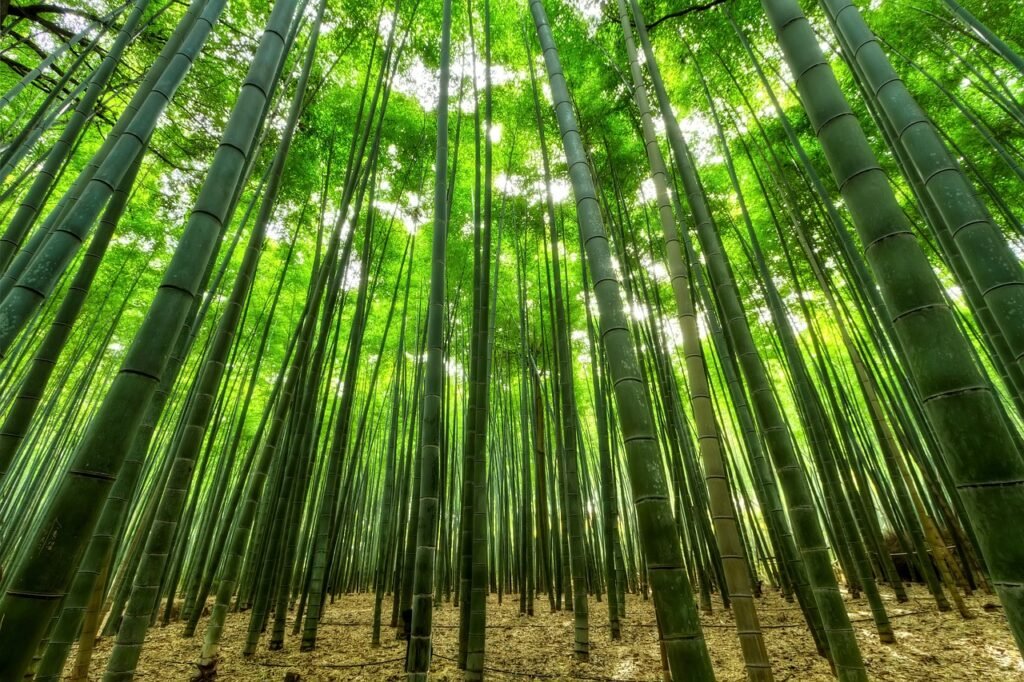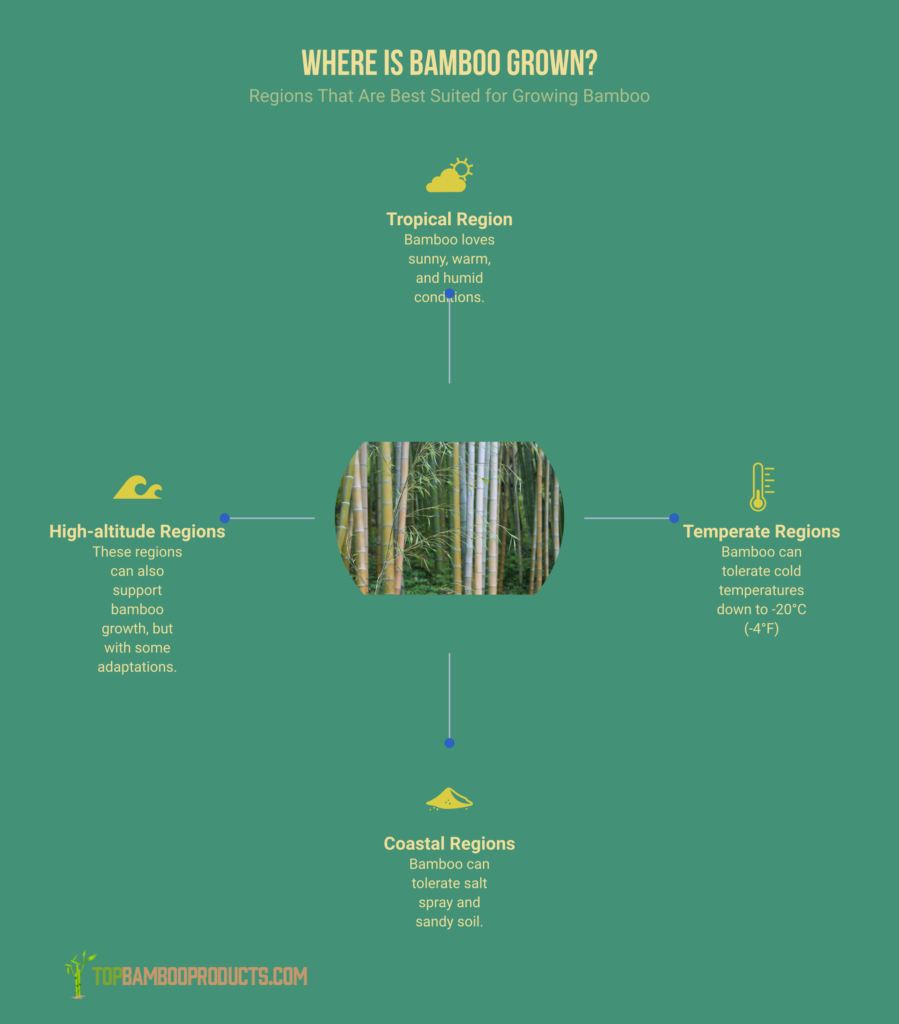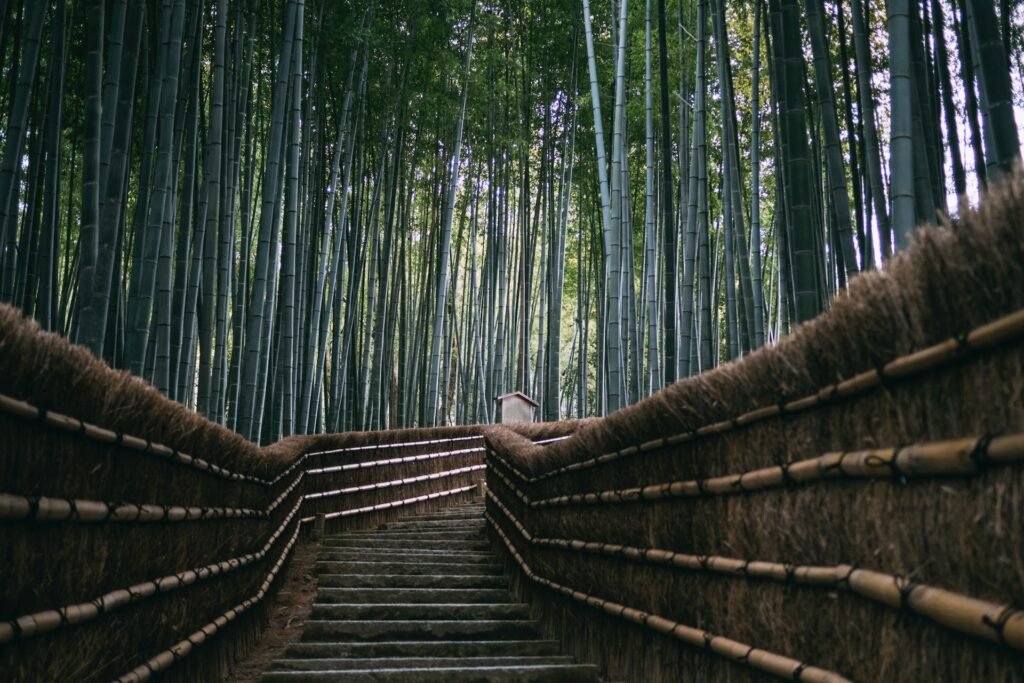Where Is Bamboo Grown? Exploring World-Wide Cultivation

0Shares
Are you wondering where is bamboo grown? Bamboo is a fascinating plant growing on Earth for millions of years. It symbolizes resilience, strength, rapid growth, and remarkable versatility. So where is bamboo grown? Well, the good news is that you can find bamboo in many parts of the world, from tropical climates in Asia and South America to colder areas of North America and Europe. It thrives in various environments, from mountainous regions to river valleys and coastal areas.
So whether you want to admire its beauty or harvest its many benefits, you can find bamboo plants in numerous places around the globe. Let’s explore some of the most popular regions where this amazing plant can be grown and more of these fascinating facts about bamboo.
An Overview of the Bamboo Plants

Bamboo plants are a fascinating species to explore. Not only are they visually stunning with their tall, slender stalks and delicate leaves, but they also possess a multitude of practical uses. Bamboo has long been utilized in various cultures worldwide, from building materials to food sources. As someone who values sustainable living and eco-friendly choices, you will love bamboo’s versatility and resilience.
Plus, there’s something magical about watching these swift-growing plants take root and flourish right before your eyes. Whether you’re a nature enthusiast, a DIY enthusiast, or simply looking for ways to incorporate a touch of zen into your home, bamboo plants are an excellent option to consider.
Where Is Bamboo Grown?

There are so many varieties of bamboo plants, each with its unique growing region. We we’ll take you on a trip around the world to discover where is bamboo grown and the popular varieties you can find there.
👉Asia
Bamboo is widely grown in Asia, with China leading in bamboo production. Bamboo thrives in many regions of China, including Yunnan, Fujian, and Zhejiang provinces. China’s bamboo forests produce some of the world’s largest bamboo varieties. Aside from China, you can also find different bamboo varieties in Japan, Thailand, and Vietnam, including Japanese Timber Bamboo and Bambusa Blumeana respectively.
India comes in second as a producer of bamboo with an estimated 10 million hectares of bamboo forests. Other countries that grow bamboo include Indonesia, Malaysia, Thailand, Vietnam, and the Philippines to name but a few.
👉Africa
Did you know that bamboo also grows in Africa? Eastern Africa and West Africa are home to many bamboo forests mainly used for construction. One of the popular varieties of bamboo grown in Africa is Guadua, which is found in countries such as Colombia, Ecuador, and Costa Rica. Guadua is known for its strength, and many homes and buildings in South America utilize this type of bamboo.
👉South America
South America is another region of the world that can boast bamboo cultivation. Brazil and Peru stand out as the leading bamboo producers in South America. Some popular bamboo types in Brazil include Phyllostachys pubescent and Bambusa vulgaris, which are used in construction and landscaping. Interestingly, bamboo utilizes in Brazil as a green alternative to hardwood timber.
👉North America and Europe
North America and Europe may not be famous for bamboo cultivation, but some varieties grows successfully in these areas. In the US, especially in the southern states, bamboo varieties such as Golden Bamboo are grown mainly for construction purposes. In Europe, various bamboo species thrive in the Mediterranean region and other Southeastern parts.
The Most Popular Bamboo Varieties
This fast-growing plant is durable and easy to maintain and comes in various types, each with its own distinct characteristics. Here are the most popular bamboo varieties and their unique qualities.
1: Golden Bamboo (Phyllostachys Aurea)
Golden bamboo is popular among homeowners as it can grow up to 40 feet tall and spread quickly. The light green leaves of this bamboo variety turn golden yellow during the fall, making it a perfect addition to any autumn garden. However, it’s important to note that golden bamboo can quickly become invasive if not properly maintained, so regular pruning must be kept under control.
2: Black Bamboo (Phyllostachys Nigra)
Black bamboo is known for its striking appearance, with dark stems that turn black over time. This variety is a favorite among gardeners due to its unique and elegant appearance and its low-maintenance and easy-to-grow nature. Black bamboo is perfect for adding height and texture to your garden design, as it can grow up to 25 feet tall.
3: Moso Bamboo (Phyllostachys Edulis)
Moso bamboo is one of the largest bamboo varieties and can grow up to 70 feet tall! It’s also known for its versatility, as you can use it in construction, furniture making, and even for making bamboo shoots for culinary purposes. This variety is perfect for homeowners who want to create a private oasis, as it can be grown in dense clumps that effectively block out sound and enhance privacy.
4: Dwarf Buddha Belly Bamboo (Bambusa Vulgaris’ Wamin’)
Dwarf Buddha Belly bamboo is a favorite among homeowners due to its unique shape, with swollen nodes resembling a Buddha’s belly. This variety can grow up to 15 feet tall and is perfect for creating a natural fence or barrier. Dwarf Buddha belly bamboo also has a high degree of drought tolerance, making it an excellent choice for hot and dry climates.
5: Giant Timber Bamboo (Bambusa Oldhamii)
Giant timber bamboo is known for its sturdiness and durability, making it an excellent choice for construction. This variety can grow up to 80 feet tall and has a thick trunk that can be used for various purposes. Giant timber bamboo is also an excellent choice for landscaping, as it can be grown in a variety of different shapes and sizes, making it perfect for creating a unique and eye-catching design.
There are just the most popular ones. However, there are over 1,000 species of bamboo, so if you are interested in growing bamboo, you have a variety to choose from.
Regions That Are Best Suited for Growing Bamboo

Not all regions are ideal for growing bamboo, as different species have different environmental requirements. Here are some regions that are best suited for growing bamboo and why.
🌿Tropical Region
Tropical regions, such as Southeast Asia, Central and South America, and Africa, are the prime locations for growing bamboo. This is because bamboo loves sunny, warm, and humid conditions, with temperatures ranging from 20°C to 35°C (68°F to 95°F). These regions also have a year-round growing season, with abundant rainfall and high levels of organic matter in the soil. The most commonly cultivated species in these areas are the giant and black bamboo, which can reach heights of up to 30 meters (98 feet) and 15 meters (49 feet), respectively.
🌿Temperate Regions
Temperate climates, such as the United States, Europe, and East Asia, can also support bamboo growth, but with some limitations. While bamboo can tolerate cold temperatures down to -20°C (-4°F), it requires a longer growing season and more moisture in these regions. The best species for these areas are the Fargesia and Phyllostachys, which are smaller and more cold-hardy than their tropical counterparts. However, growing temperate bamboo may require extra care and attention, such as mulching, fertilizing, and protecting the plants from harsh winds and frost.
🌿Coastal Regions
Coastal regions, such as Northern Australia, New Zealand, and the Pacific Islands, are also suitable for growing bamboo, especially near the shoreline. Bamboo can tolerate salt spray and sandy soil, which are common in these areas. The most popular species for coastal planting are the clumping bamboo, which can form dense screens and hedges for privacy and windbreak purposes. These species also have a lower risk of invading other areas compared to the running bamboo, which can spread aggressively if not managed properly.
🌿High-altitude Regions
High-altitude regions, such as the Himalayas, the Andes, and the Rocky Mountains, can also support bamboo growth, but with some adaptations. These areas have colder temperatures and less moisture than tropical regions, meaning bamboo species that can survive in these conditions must have thicker stems and smaller leaves. The most suitable species for high-altitude planting are the Sinarundinaria, Chusquea, and Thamnocalamus, which can grow up to 6 meters (20 feet) and provide shelter and food for the native fauna.
No matter what region you live in, a bamboo species can thrive in your area. With the proper care and knowledge of the environmental requirements for each species, you can create a beautiful and sustainable bamboo garden!\
Advantages and Disadvantages of Bamboo Plantation
Today, bamboo has become increasingly popular for commercial plantation and production, but there are still certain advantages and disadvantages of growing bamboo.
Advantages of Bamboo Plantation:
✅Fast Growth Rate
Bamboo is one of the fastest-growing plants in the world. It can grow up to two feet per day, depending on the climate, soil conditions, and species. It is beneficial to farmers who want to maximize crop production. Also, the quicker the plant grows, the faster carbon dioxide is absorbed, helping the environment.
✅Environmental Sustainability
Bamboo is an eco-friendly plant that can grow in marginal land unsuitable for cultivating other crops. It’s also sustainable because, unlike other trees, it does not require replanting after harvest, as the root system remains undisturbed. Additionally, bamboo can absorb 30% more carbon dioxide and produce 30% more oxygen than other plants, making it a viable candidate for reducing greenhouse gases.
✅Multiple Uses
Bamboo can be used for different purposes, including construction, paper, furniture, textiles, and even food. Bamboo shoots are rich in nutrients and commonly used in Asian cuisine. Therefore, the versatility of bamboo allows farmers to make multiple income streams.
Disadvantages of Bamboo Plantation:
❎High Startup Cost
Setting up a bamboo plantation comes at a high initial investment cost, making it inaccessible to small-scale farmers. This cost includes clearing the land, buying seedlings, and setting up irrigation systems for optimal growth.
❎Invasive Nature
Bamboo is known to be an invasive species that can spread uncontrollably and choke local flora and fauna if not adequately controlled. Therefore, proper management and maintenance are necessary to prevent it from harming the ecosystem.
❎Vulnerability to Pests
Despite being hardy, bamboo is prone to pests and diseases such as mites, fungi, and bacterial infections. These can lead to poor crop quality and yield, which farmers must be prepared to deal with.
These pros and cons of bamboo plantation need to be carefully considered before embarking on this venture.
How Much Land Do You Need for a Profitable Bamboo Plantation?

Firstly, let’s clarify that bamboo plantations use clumps instead of traditional tree rows per acre. Clumps are groups of bamboo plants that grow close together, and the actual number of plants within a clump varies depending on the species. You can grow bamboo on a range of soil types, including degraded and acidic soils and climates from tropical to temperate regions.
The general rule of thumb is planting 400 clumps per hectare or approximately 160 clumps per acre, depending on the bamboo species. If you want a higher yield, it is recommended that you plant on at least one hectare of land. However, the land you need for your bamboo plantation depends on your objectives, the species you intend to plant, and your geographical location.
A good starting point is to assess the land’s availability and the species of bamboo that thrive in your region. For instance, clumping bamboo species, such as Bambusa vulgaris or Dendrocalamus asper, don’t require huge expanses of land, but running bamboo species, such as Phyllostachys bambusoides, require more space. You also need to consider the spacing between the clumps and the amount of sunlight, water, and nutrients each clump requires.
Bamboo plantations require a long-term approach, as it can take between three to five years before you can start harvesting your mature bamboo. The land you choose should also have adequate drainage and be protected from strong winds, diseases and pests, and human encroachment. The success of a bamboo plantation requires a sufficient amount of crucial seedlings, labor, and maintenance activities.
Tips for Growing Bamboo in Your Garden
Bamboo is a fast-growing plant that can quickly establish itself in the garden, but there are some things you need to know before growing bamboo in your garden. Here are some tried-and-tested tips for growing bamboo in your garden.
1: Choose the Right Bamboo Variety
Numerous types of bamboo are available, so it’s crucial to choose the right variety for your garden. Some bamboo species can grow up to 60 feet tall, while others are smaller and more suited for container planting. Before selecting a bamboo variety, consider your garden’s climate, soil type, and sunlight requirements. Do your research and consult with the local nursery before purchasing or planting bamboo.
2: Prepare Soil Adequately
Bamboo requires well-drained soil with plenty of organic matter. It’s suggested to amend the soil with compost or peat moss before planting bamboo. Dig the soil deep to loosen any compacted soil and remove any weeds thoroughly.
3: Watering and Fertilizing Bamboo
Bamboo needs at least 1 inch of water weekly. It’s essential to check with your local water authority regarding the watering regulations in your area. Bamboo is a fast-growing plant that can benefit from regular fertilization. You can use balanced fertilizers once in two months during the growing season, but avoid using anything with high nitrogen content. High nitrogen fertilizers can cause the bamboo to grow rapidly, resulting in weak culms.
4: Contain The Spread
Bamboo can spread rapidly, and if not adequately contained, it can invade neighboring properties. Therefore, it’s crucial to plant bamboo with a root barrier, a physical barrier that is sunk into the soil around the plant to restrict its growth. Another option is trenching to remove any escaping roots and rhizomes.
5: Pruning Bamboo Plants
Although bamboo is a low-maintenance plant, pruning should be done regularly. It keeps the plant neat and tidy and encourages thicker growth of shoots. Pruning also helps to control excessive growth – be sure to remove any weak or dead stems.
6: Consider the Light Requirements
Most varieties of bamboo thrive in full sun, but some can also grow in partial shade. It’s worth researching the specific light requirements of your chosen bamboo type before planting. Some species will do better in shade or direct sunlight than others, so you must be aware before planting.
These are just some tips for growing bamboo in your garden. You’ll be rewarded with a lush green bamboo grove for years of enjoyment with the proper care and attention.
Frequently Asked Questions
Q: Does bamboo grow in the Philippines?
Yes, bamboo grows abundantly in the Philippines. This country is one of the few tropical countries with the largest bamboo resources worldwide. According to DENR, the government agency tasked with environmental protection, our country has an estimated 4 million hectares of bamboo forest—the equivalent of 3.3 billion bamboo culms. The most common bamboo species in the Philippines are kawayan tinik, giant bamboo, bayog, and botong.
Q: What is the main purpose of bamboo?
Bamboo’s primary function is not only limited to providing us with building materials or furniture. It has several other purposes, which include food, medicine, paper, and even textile. The young bamboo shoot is commonly cooked in some regions and is considered a delicacy. Bamboo leaves and stems are used in traditional medicine to cure various ailments. Bamboo is an eco-friendly paper source because of its rapid growth, while its fiber is used to make durable and breathable fabrics.
Q: What are the benefits of bamboo?
Bamboo is eco-friendly, renewable, and sustainable. Unlike traditional hardwood trees used for construction and furniture, bamboo can grow up to 91 cm in just one day. It can even reach maturity in 3-5 years, compared to hardwood trees that take decades to mature. Bamboo can absorb up to five times as much carbon dioxide and produce 35% more oxygen than other trees. Bamboo can also prevent soil erosion and protect our waterways from pollution.
Q: Can bamboo be used for sustainable living?
Yes, bamboo is an ideal material for sustainable living. Its versatility and resilience make it perfect for various applications such as housing construction, furniture, and home decor. Moreover, bamboo is an excellent alternative to plastic, which is harmful to both our health and the environment. Bamboo utensils, straws, and packaging replace plastic in some restaurants and stores because of their compostable and sustainable nature.
Q: How can we encourage bamboo growth?
We can encourage bamboo growth by supporting local businesses that use and promote bamboo products. Planting and nurturing bamboo plants in our backyard and community can also help, along with educating others about the importance of bamboo to our environment. In addition, we can advocate for better policies and regulations that protect bamboo resources and regulate their harvesting to ensure their sustainability.
Final Words
After reading this article, you should better understand where bamboo is grown. Bamboo can be found in various climates and terrains from Asia to South America. As someone who loves to travel, I find it exciting that I could potentially stumble upon bamboo forests in my adventures. But bamboo isn’t just a beautiful plant to admire – it’s also incredibly useful. It can be used in construction, furniture, paper products, and even clothing! The versatility of bamboo is truly remarkable.
With proper care and maintenance, you can even grow it in your own backyard. If you plan on doing so, do your research and ensure you have the right conditions for growing bamboo. Good luck!
0Shares






